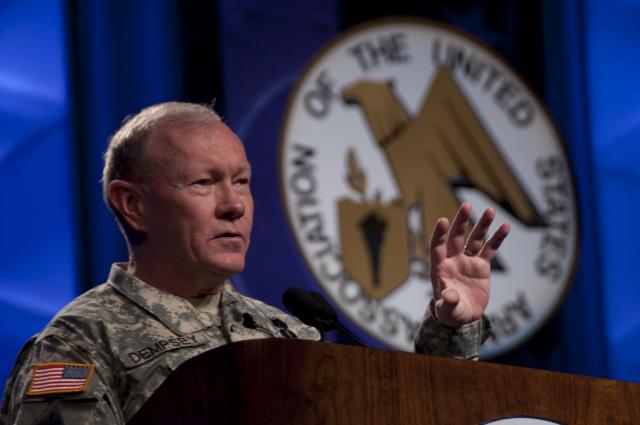The Defense Department’s new military strategy offers it more opportunities than liabilities, and the military is not being victimized by the need for a leaner budget, Gen. Martin E. Dempsey said tonight.
The chairman of the Joint Chiefs of Staff addressed hundreds of attendees at Duke University’s Page Auditorium during the annual Ambassador S. Davis Phillips Family International Lectureship.
“The real question from me to the service chiefs and the secretary of defense is how can we look at changing the way we deliver our objectives given these [budget constraints] and, actually, its enormous opportunity,” Dempsey said.
“I think there is as much opportunity as liability,” he added.
The chairman stressed that the military services are not being victimized by the U.S. economic crisis.
“We clearly have a role to play, all of us as citizens, in helping the nation address this economic crisis,” he said. “We understand that for the nation to overcome its debt crisis and some of the other economic challenges it has, we have to get a hold of costs. And we will.”
Dempsey added, “This is something that we, the Joint Chiefs, have embraced as what’s best for America, and we’ll figure it out.”
The most important part of the emerging defense strategy “and where we’re trying to get between now and 2020,” he said, is that the United States is and must always be a world power.
President Barack Obama released the strategic guidance alongside Defense Secretary Leon E. Panetta and Dempsey at the Pentagon on Jan. 5. The guidance describes how the military will maintain superiority by becoming more agile, flexible and ready for the full range of contingencies and threats.
The strategy honors four principles — that the U.S. military must remain preeminent, that there will be no hollow force, that financial savings must be balanced, and that the all-volunteer force must be preserved, keeping faith with men and women in uniform and their families.
“It’s a real strategy,” Dempsey told the Duke University audience. “We made some real choices. We’ve taken real ownership of it. It seeks a balance of principle and pragmatism.”
The nation’s military needs in 2020 are “what we should be thinking about,” Dempsey said.
That means some combination of changed relationships between the traditional and conventional military components, the emerging components such as cyber, the lessons of the last 10 years of war, especially special operations forces, the chairman added.
“It’s a new relationship among the services potentially a change in the way we approach security challenges [and] shifts in geographic priorities,” he said.
Also changed is the two-war construct, Dempsey said — the idea that arose in the era of the Soviet Union that the United States should be able to fight two large-scale land wars at the same time.
“Somebody said, ‘Aha, you’re taking that language out because now you’re only going to fight one war,” he said. “I would never say that. The nation doesn’t need a military that can only do one thing at a time. The nation needs a military that can do multiple things” to give the nation’s leaders as many options as possible.
Taking the two-war wording out of the defense strategy released the department from the “tyranny of language” associated with that construct, Dempsey said.
“That was fine when the world was like that and it was fine when resources were not an independent variable,” the chairman said, “and so by freeing ourselves from that tyranny of vocabulary I think what we can actually allow ourselves to do now is to think differently about how we achieve the outcome.”











